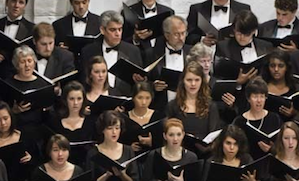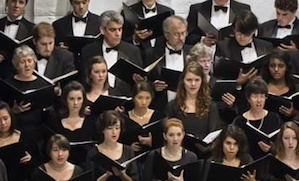
It was Leonard Bernstein who, in the aftermath of John F. Kennedy’s assassination in 1963, said, “This will be our reply to violence: to make music more intensely, more beautifully, more devotedly than ever before.”
With these same words, Executive Director Alan Silow dedicated Saturday afternoon’s concert by the Santa Rosa Symphony (SRS) and the Sonoma Bach Choir to the memory of the victims of the unspeakable tragedy that was the school shooting in Newtown, Connecticut, last Friday.
It added extra weight to what was already destined to be a memorable concert. This was the orchestra’s first choral special in the fantastic new Weill Hall of the Green Music Center at Sonoma State University, and on the program was Bach’s Mass in B Minor, BWV 232. This monumental masterpiece is a longtime favorite of Donald and Maureen Green, the founding donors for whom the music center is named, and both of whom sang in the Sonoma Bach Choir for many years.
Choosing Bach’s Mass for this occasion may have been a no-brainer for SRS Choral Director Robert Worth, yet it is an ambitious undertaking nonetheless. In his excellent and informative article in the program notes, Worth describes the Mass in B Minor as “a musical resumé … in which [Bach] sought from among his many existing works the perfect music to express the given text. [The Mass is] a portfolio representing [his] compositional technique in all its diversity, spanning 35 years of his career.”
Worth conducted the Sonoma Bach Choir, along with five soloists: Carol Menke, soprano; Jenni Samuelson, mezzo-soprano; Jennifer Lane, mezzo-soprano; Scott Whitaker, tenor; and Paul Murray, bass. They were accompanied by principal musicians of the Santa Rosa Symphony.
The Mass in B Minor would be Bach’s definitive example of sacred vocal music.
The Mass in B Minor is one of the compositions that Johann Sebastian Bach (1685–1750) created toward the end of his life, quite likely as a final summation of his art as a composer. The Art of the Fugue could be seen as his ultimate instrumental composition, whereas the Mass in B Minor would be his definitive example of sacred vocal music. Even though he was a Lutheran composer working in a Lutheran environment, he would have no direct use for a Roman Catholic Mass.
In his B-minor Mass, Bach incorporates examples of virtually every musical style that he mastered, and he “parodied” or reused and adapted existing music from his earlier works, in the case of the Sanctus as far back as 1724.
Intense Challenge
This all puts a heavy burden on the performers. Conductor, singers, and instrumentalists have to develop a deep, collective understanding of Bach’s progression through various styles and treatment of text and music, in order to give the Mass a performance that creates a coherent musical and contextual arc, from the first chord of the Kyrie to the final notes of Dona Nobis Pacem. In between, the performers must transition between the intimacy of a four-person chamber ensemble in the Benedictus (tenor, flute, and organ/cello continuo) to a jubilant Et resurrexit with five-part chorus and full orchestra, including festive trumpets and timpani. That is never easy, and conductor Robert Worth had his hands full keeping the separate groups of performers in the same style period.
Entirely at the service of chorus and soloists, the principal members of the Santa Rosa Symphony did excellent work.
With its mellow, homogeneous, and nicely balanced sound, the Sonoma Bach Choir was particularly impressive in the opening Kyrie, the Cum Sancto Spiritu, and the Osanna in excelsis. An occasional lapse in pitch notwithstanding, the singers blended well in the melodic lines of Bach’s many fugues, for instance in Pleni sunt coeli. The five fine vocal soloists performed equally well; especially delightful were mezzos Samuelson and Lane in the duet Et in unum Dominum.
Entirely at the service of chorus and soloists, the principal members of the Santa Rosa Symphony did excellent work, with truly outstanding solos in the oboe, English horn, flute, trumpet, and cello.

